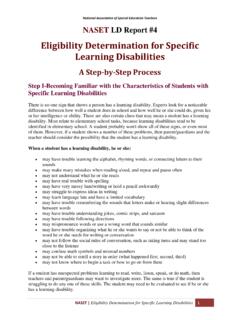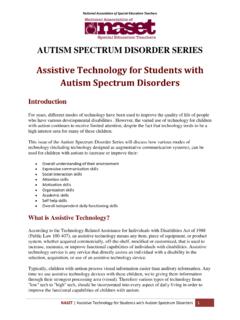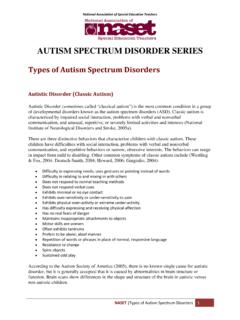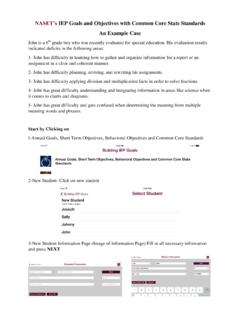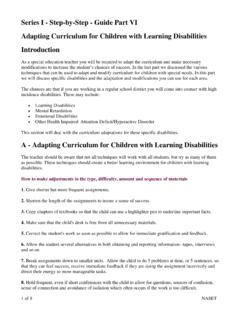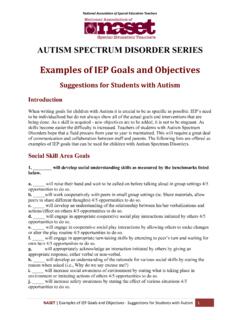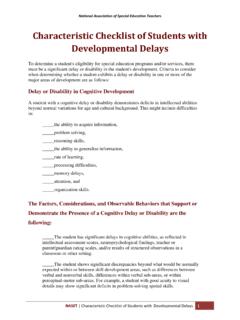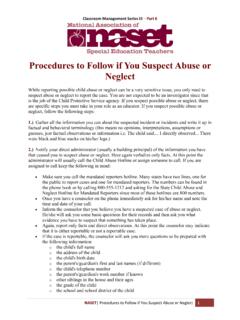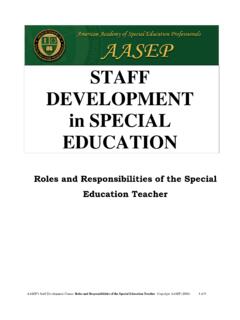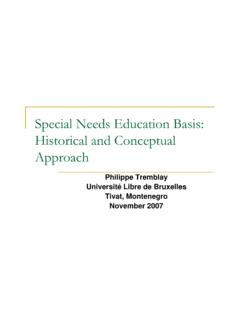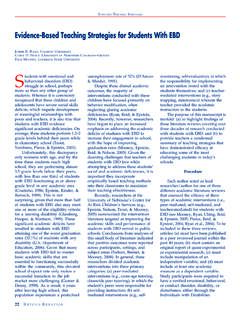Transcription of Characteristics of Children with Learning Disabilities
1 National Association of Special Education Teachers NASET LD Report #3. Characteristics of Children with Learning Disabilities Children with Learning Disabilities are a heterogeneous group. These Children are a diverse group of individuals, exhibiting potential difficulties in many different areas. For example, one child with a Learning disability may experience significant reading problems, while another may experience no reading problems whatsoever, but has significant difficulties with written expression. Learning Disabilities may also be mild, moderate, or severe.
2 Students differ too, in their coping skills. According to Bowe (2005), some learn to adjust to LD so well that they pass' as not having a disability, while others struggle throughout their lives to even do simple' things. Despite these differences, LD always begins in childhood and always is a life-long condition (p. 71). Over the years, parents, educators, and other professionals have identified a wide variety of Characteristics associated with Learning Disabilities (Gargiulo, 2004). One of the earliest profiles, developed by Clements (1966), includes the following ten frequently cited attributes: Hyperactivity Impulsivity Perceptual-motor impairments disorders of memory and thinking emotional labiality Academic difficulties Coordination problems Language deficits disorders of attention Equivocal neurological signs Almost 35 years later, Lerner (2000) identified nine Learning and behavioral Characteristics of individuals with Learning Disabilities .
3 disorders of attention Reading difficulties Poor motor abilities Written language difficulties Oral language difficulties Social skills deficits Psychological process deficits Quantitative disorders Information processing problems NASET | Characteristics of Children with Learning Disabilities 1. National Association of Special Education Teachers According to Gargiulo (2004), not all students with Learning Disabilities will exhibit these Characteristics , and many pupils who demonstrate these same behaviors are quite successful in the classroom.
4 As Smith (1979) observes, it is the quantity, intensity, and duration of the behaviors that lead to the problems in school and elsewhere. The focus of this LD Report will be to discuss the most commonly seen Characteristics of Children with Learning Disabilities . In almost all cases, a single student will not have deficits in all areas. Understanding the Characteristics of Children with Learning Disabilities is absolutely essential as a future educator in developing prereferral interventions, in making appropriate referrals, and in identifying effective adaptations and intervention strategies (Smith et al.)
5 , 2004). Academic Achievement Deficits Children with Learning Disabilities often struggle with various areas of academic performance. During the elementary school years, a discrepancy between ability and achievement begins to emerge in students with Learning Disabilities . Often puzzling to teachers, these students seem to have strengths similar to their peers in several areas, but their rate of Learning is unexpectedly slower (Smith et al., 2004). These problems usually persist from the primary grades through the end of formal schooling, including college (Bradshaw, 2001).
6 Academic deficits for Children with Learning Disabilities normally fall into the following areas: reading, mathematics, and written expression. Some Children have problems in only one select academic area, while others may experience difficulties in all three. Reading Deficits Reading provides a fundamental way for individuals to exchange information. It is also a means by which much of the information presented in school is learned. As a result, reading is the academic area most often associated with academic failure.
7 Reading is a complex process that requires numerous skills for its mastery. Consequently, identifying the skills that lead to success in reading is extremely important. Reading difficulties are observed among students with Learning Disabilities more than any other problem area of academic performance. It is the most prevalent type of academic difficulty for students with Learning Disabilities . It is estimated that as many as 90% of students with Learning Disabilities have reading difficulties, and even the low estimates are approximately 60% (Bender, 2001).
8 Most authorities believe that this problem is related to deficient language skills, especially phonological awareness the ability to understand that speech flow can be broken into smaller sound units such as words, syllables, and phonemes. According to Hallahan and Kauffman (2003), it is easy to see why problems with phonology would be at the heart of many reading difficulties. A person who has problems breaking words into their component sounds will have trouble Learning to read. And there is suggestive evidence that readers of English are more susceptible than readers of some other languages to problems with phonological awareness.
9 Some have speculated that this is why reading Disabilities are more prevalent in English-speaking countries than in some other countries (p. 162). NASET | Characteristics of Children with Learning Disabilities 2. National Association of Special Education Teachers Becoming a skilled reader is so important in our culture that an unskilled reader is at a great disadvantage in school and in the workplace. The following problems may prevent a child with Learning Disabilities from Learning to read (Kirk, Gallagher, & Anastaiow, 2003, p.)
10 224). Faulty auditory perception without hearing impairment Slow auditory or visual processing Inability to distinguish or separate the sounds of spoken words Lack of knowledge of the purpose of reading Failure to attend to critical aspects of the word, sentence, or paragraph Failure to understand that letters represent units of speech Recent research has begun to reveal a great deal about the fundamental nature of Children 's reading Disabilities and the type of instruction most likely to remediate reading problems (Jenkins & O'Connor, 2001).
